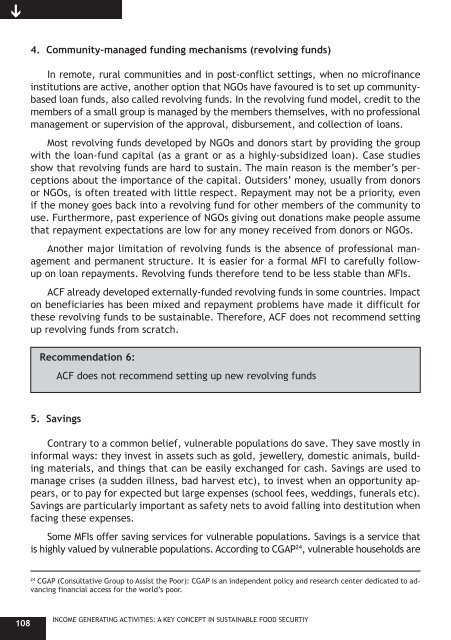Income-Generating Activities - Action Against Hunger
Income-Generating Activities - Action Against Hunger
Income-Generating Activities - Action Against Hunger
You also want an ePaper? Increase the reach of your titles
YUMPU automatically turns print PDFs into web optimized ePapers that Google loves.
➔<br />
4. Community-managed funding mechanisms (revolving funds)<br />
In remote, rural communities and in post-conflict settings, when no microfinance<br />
institutions are active, another option that NGOs have favoured is to set up communitybased<br />
loan funds, also called revolving funds. In the revolving fund model, credit to the<br />
members of a small group is managed by the members themselves, with no professional<br />
management or supervision of the approval, disbursement, and collection of loans.<br />
Most revolving funds developed by NGOs and donors start by providing the group<br />
with the loan-fund capital (as a grant or as a highly-subsidized loan). Case studies<br />
show that revolving funds are hard to sustain. The main reason is the member’s perceptions<br />
about the importance of the capital. Outsiders’ money, usually from donors<br />
or NGOs, is often treated with little respect. Repayment may not be a priority, even<br />
if the money goes back into a revolving fund for other members of the community to<br />
use. Furthermore, past experience of NGOs giving out donations make people assume<br />
that repayment expectations are low for any money received from donors or NGOs.<br />
Another major limitation of revolving funds is the absence of professional management<br />
and permanent structure. It is easier for a formal MFI to carefully followup<br />
on loan repayments. Revolving funds therefore tend to be less stable than MFIs.<br />
ACF already developed externally-funded revolving funds in some countries. Impact<br />
on beneficiaries has been mixed and repayment problems have made it difficult for<br />
these revolving funds to be sustainable. Therefore, ACF does not recommend setting<br />
up revolving funds from scratch.<br />
Recommendation 6:<br />
ACF does not recommend setting up new revolving funds<br />
5. Savings<br />
Contrary to a common belief, vulnerable populations do save. They save mostly in<br />
informal ways: they invest in assets such as gold, jewellery, domestic animals, building<br />
materials, and things that can be easily exchanged for cash. Savings are used to<br />
manage crises (a sudden illness, bad harvest etc), to invest when an opportunity appears,<br />
or to pay for expected but large expenses (school fees, weddings, funerals etc).<br />
Savings are particularly important as safety nets to avoid falling into destitution when<br />
facing these expenses.<br />
Some MFIs offer saving services for vulnerable populations. Savings is a service that<br />
is highly valued by vulnerable populations. According to CGAP 24 , vulnerable households are<br />
24<br />
CGAP (Consultative Group to Assist the Poor): CGAP is an independent policy and research center dedicated to advancing<br />
financial access for the world’s poor.<br />
108<br />
INCOME GENERATING ACTIVITIES: A KEY CONCEPT IN SUSTAINABLE FOOD SECURTIY

















